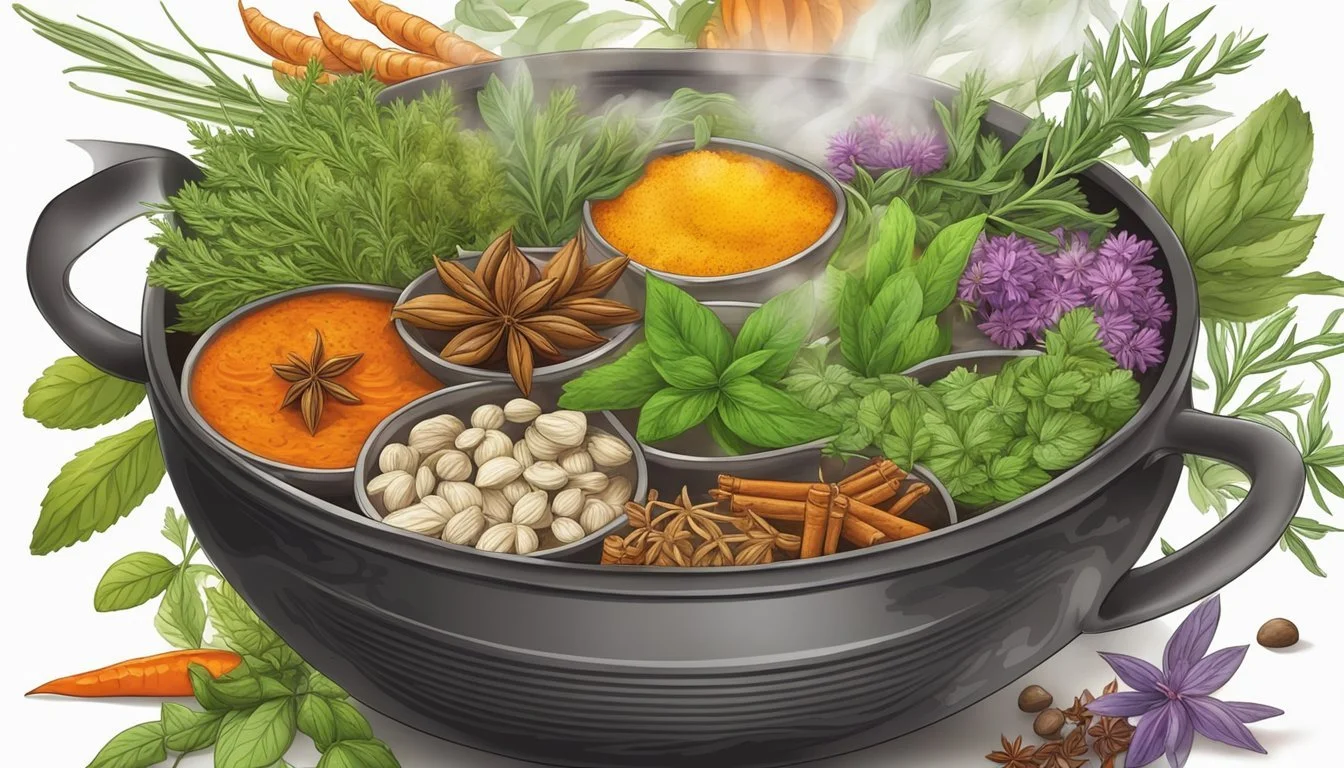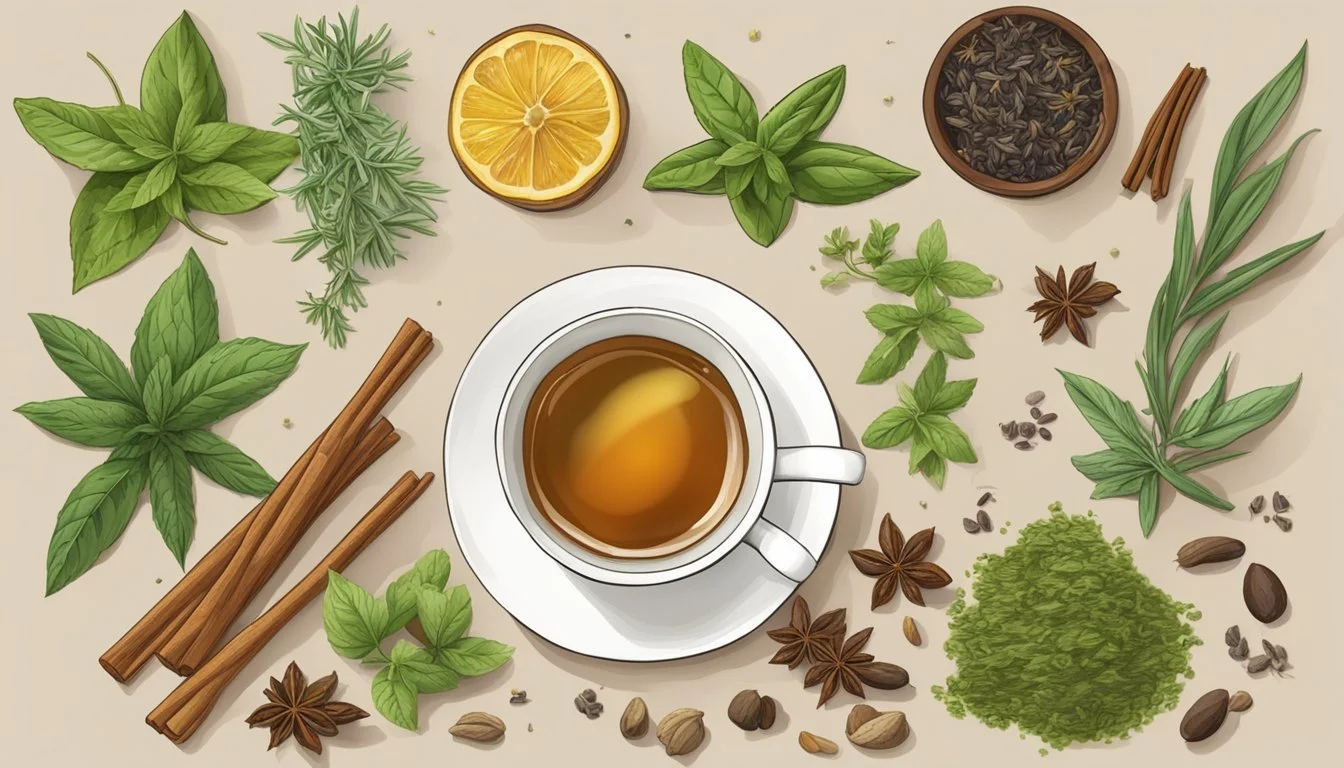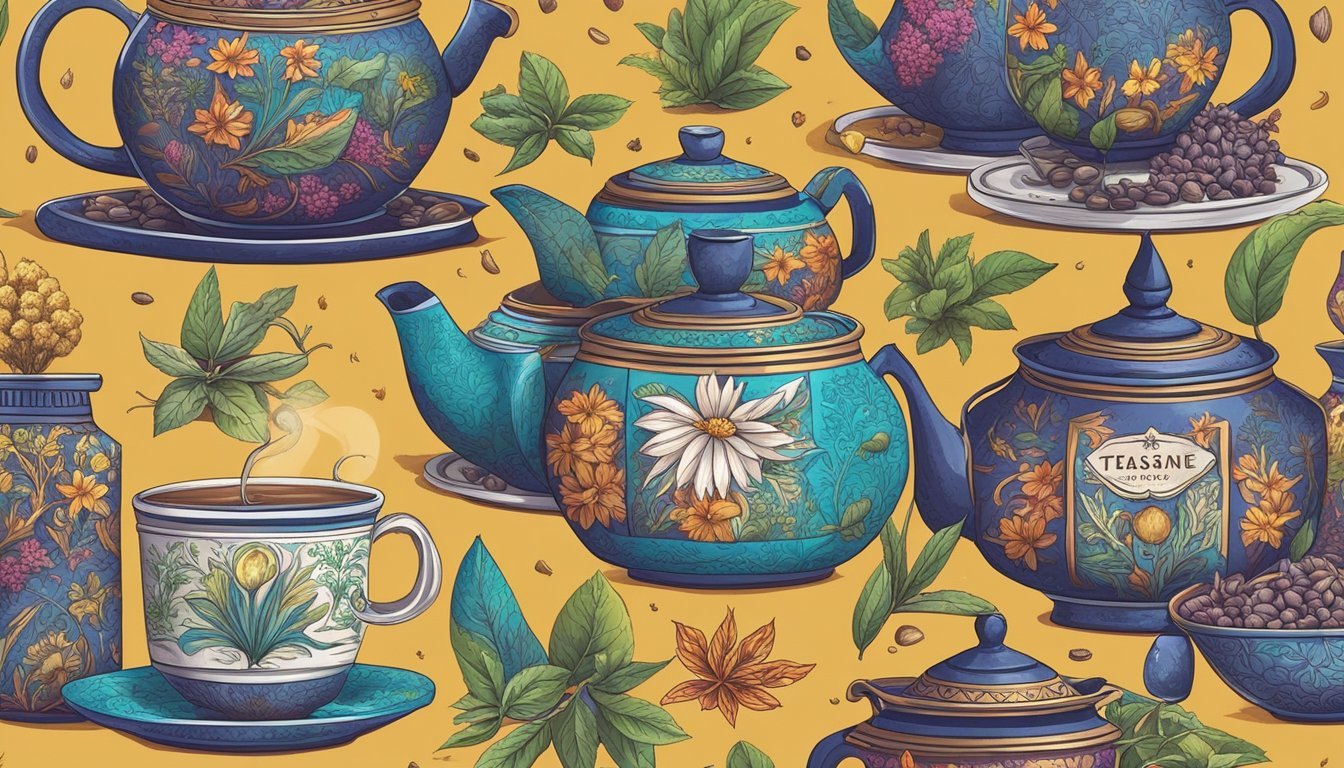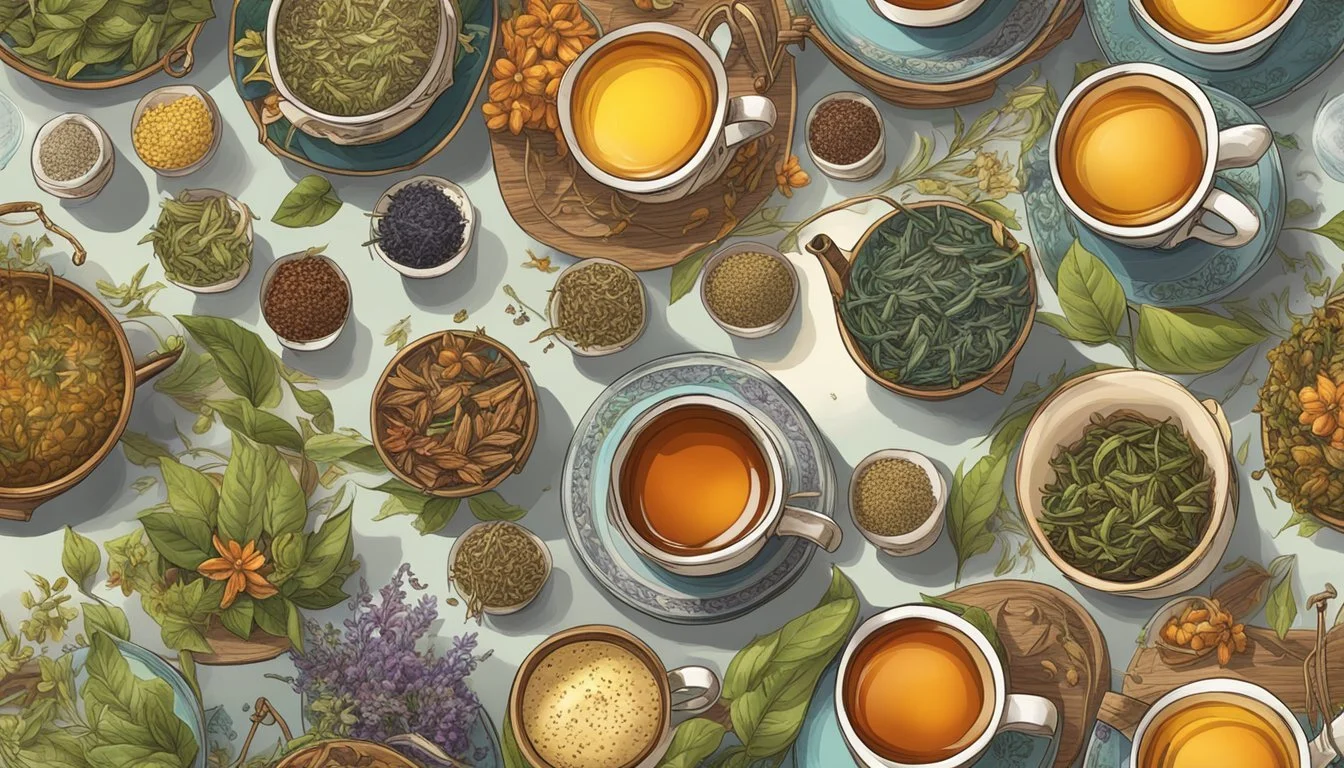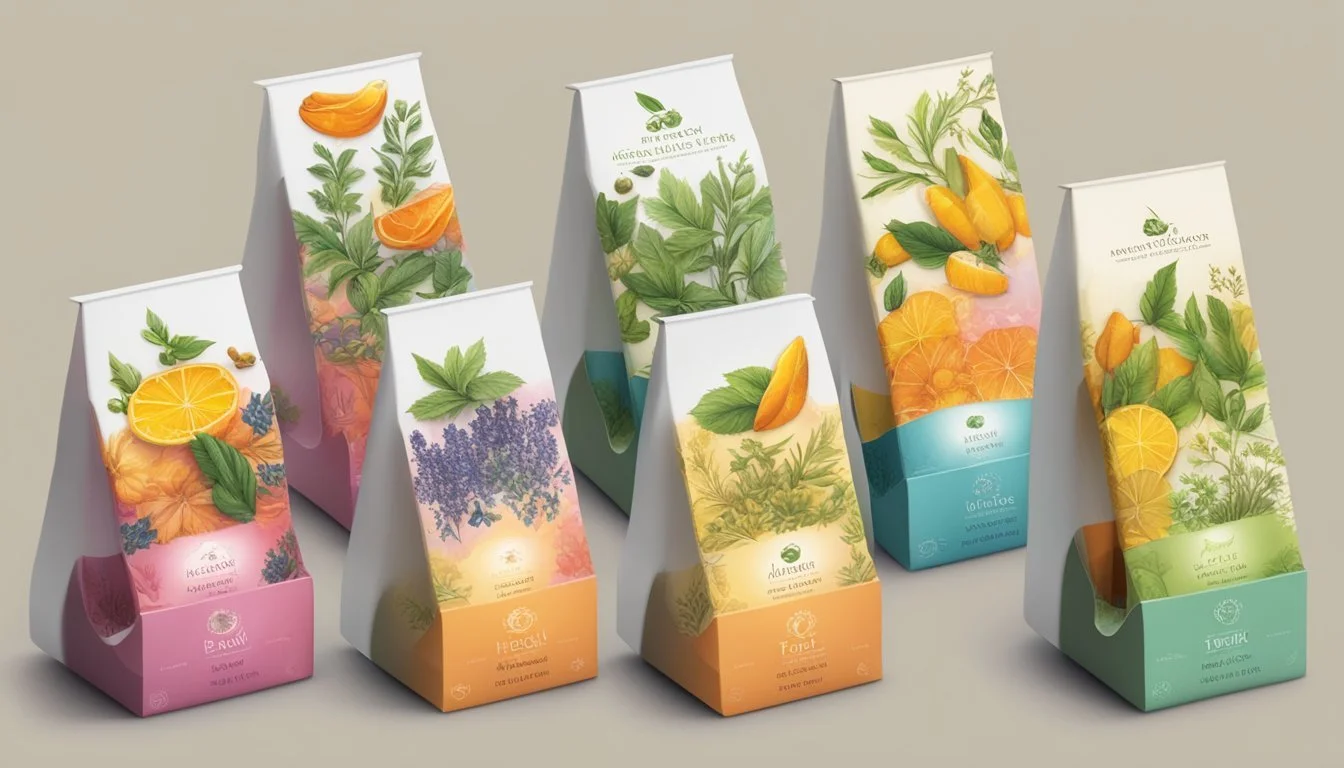Swicy Herbal Infusions
Unleashing Bold Flavors in Modern Teas and Tisanes
In the realm of herbal infusions, a delightful trend has been steeping: the rise of "Swicy" herbal teas—a term coined to capture the unique fusion of sweet and spicy flavors. These infusions offer a multifaceted sensory experience, enchanting the palate with layers of taste that are both comforting and invigorating. Often naturally caffeine-free and steeped in potential health benefits, these blends cater to a wide audience seeking both flavor and wellness.
Swicy herbal infusions marry ingredients like cinnamon, licorice root, and sarsaparilla with peppermint, raspberry leaves, and orange peel to create a harmonious balance. The sweet aspects of these ingredients, often enhanced by the likes of papaya leaf or fennel seed extract, are brilliantly contrasted by the subtle kick of spices, delivering a complex taste profile that has captured the attention of tea enthusiasts.
Given the variety of available herbs and spices, the spectrum of swicy infusions is remarkably diverse. From the warming embrace of a cinnamon and chicory blend to the refreshing zip of spearmint with a hint of clove, each combination offers a distinct experience. As more individuals discover these exquisite blends, swicy teas are quickly becoming a staple for those seeking comfort and zest in their cup.
The Rise of Swicy Flavors
The fusion of sweet and spicy, known as 'Swicy,' is a trend taking over taste buds across generations, gaining traction in both homemade beverages and restaurant offerings.
Cultural Influence and Generational Preferences
Generations, notably Gen Z and Millennials, have demonstrated a penchant for flavors that dance between sweet and spicy. Studies by market research firms, such as Datassential, reveal a significant upsurge in swicy pairings, a testament to their broadening appeal. Swicy preferences reflect a cultural shift where daring palates favor complexity and novelty in their foods and beverages.
Swicy in Mainstream Cuisine
Mainstream culinary outlets have quickly adapted to this trend. Swicy options are now more prevalent, with eateries like Pizza Hut, Chick-fil-A, and Outback Steakhouse incorporating this flavor profile into their menus. The addition of swicy infusions in teas and tisanes exemplifies creativity and a response to consumer demands, as these nuanced flavors cater to the adventurous tastes of modern diners.
Swicy Herbal Infusion Essentials
Exploring the unique fusion of sweet and spicy, Swicy Herbal Infusions offer a refreshing take on traditional teas and tisanes, promising both pleasure and a distinctive flavor experience without caffeine.
Defining Herbal Infusions
Herbal infusions, unlike traditional tea derived from the Camellia sinensis plant, consist of steeping various herbs, spices, fruits, or flowers in hot water. These beverages are naturally caffeine-free and provide an abundance of flavor profiles, making them a popular choice for those seeking a diverse and aromatic drinking experience.
Benefits of Swicy Flavors
Swicy flavors combine sweetness and spiciness, creating a harmonious and tantalizing taste. This interplay of flavors not only excites the palate but also can enhance mood with the release of endorphins triggered by the spicy notes. Herbal infusions that incorporate swicy elements offer a refreshing alternative that can stimulate the senses while providing the pleasure of a unique, multi-layered beverage.
Crafting the Perfect Swicy Blend
Creating a swicy herbal tea involves meticulous ingredient selection and precise balancing of flavors. Achieving an optimal sweet-spicy harmony requires attention to detail and careful consideration of each component's contribution to the overall sensory profile.
Selecting Quality Ingredients
The foundation of any swicy herbal infusion is its ingredients. For a tea that is both invigorating and comforting, one might choose to begin with a base of ginger and cinnamon owing to their inherently warm and spicy characteristics. To add complexity, elements such as rosehip and orange peel provide a citrusy sweetness, which can round out the sharpness of the spicier notes.
Ginger: a potent, warming spice with digestive benefits.
Cinnamon: offers a sweet, woodsy warmth and is believed to have anti-inflammatory properties.
In contrast, lemongrass and peppermint offer a fresh, cool contrast, capitalizing on their inherent aromatic qualities to elevate the swicy experience.
Lemongrass: imparts a lemony flavor that complements the sweet notes.
Peppermint: adds a minty freshness, offering a cooling sensation that balances the heat from spices.
Finally, chamomile and anise seed can be added for their sweet, floral notes, while chamomile also brings with it a soothing character, perfect for a relaxing swicy tea.
Chamomile: known for its calming properties and subtle sweetness.
Anise Seed: its licorice-like sweetness can enhance the blend’s complexity.
Each ingredient should be chosen with an eye towards their origin, potency, and freshness to ensure the final infusion is vibrant and flavorful.
Balancing Sweet and Spicy Notes
The art of developing a swicy herbal infusion lies in the balance between sweet and spicy. A masterful blend considers the intensity of each ingredient and how they interact in harmony.
Sweet Notes: Achieved with ingredients like cinnamon, rosehip, and orange peel. Their natural sweetness counteracts the heat and sharpness of the spicy components.
Spicy Notes: Derived from ginger, anise seed, and cinnamon. The key is to use them judiciously, allowing the sweet elements to surface without being overshadowed.
Ingredient Sweetness Spiciness Cinnamon Medium Medium Ginger Low High Anise Seed High Low Orange Peel High Low Rosehip High Low Lemongrass Medium Low Peppermint Low Low
The brewing process itself also has a critical role in how these flavors meld. By adjusting the steeping time and temperature, one can fine-tune the prominence of sweetness or spiciness to reach the desired swicy profile.
Innovative Swicy Products
The synergy of sweet and spicy, known as swicy, is proving to be more than just a flavor trend—it's a growing niche within the tea and tisane market. Consumers are increasingly drawn to unique tastes that challenge the palate.
Market Trends and Consumer Demand
The swicy movement is more than a fleeting craze; it reflects an evolving consumer palette that craves complexity and depth in their beverages. According to recent market analysis, there is a 38% increase in sweet and spicy pairings on menus. Hot honey and similar swicy infusions are expected to outpace nearly all other flavors in the culinary landscape. Consumers are specifically looking for products that combine traditional comforting teas with daring spicy notes to create a multifaceted drinking experience.
Consumer Preferences:
Sweet and spicy profiles are favored.
Interest in herbal infusions with swicy twists is on the rise.
Reviewing Popular Swicy Brands
Several brands have successfully introduced swicy elements into their product lines to meet the growing consumer demand. Torani is one brand that has embraced the swicy trend, infusing their syrups with a balance of sweetness and heat, turning ordinary beverages into favorites with an added kick. Another prominent brand, Good Earth, offers a selection of teas that perfectly embody the swicy concept. Their blends often feature bold spices paired with subtle sweet notes, delivering a delicious and aromatic experience for the adventurous tea consumer.
Notable Swicy Products:
Torani Syrups: These syrups can be added to both food and beverages for a swicy flavor boost.
Good Earth Teas: These tea blends are known for their natural ingredients and innovative swicy combinations.
Companies are leveraging the swicy trend not just for the novelty, but as a testament to their commitment to innovation and understanding of the evolving taste preferences. Consumers can look forward to a continually expanding selection of swicy-flavored teas and tisanes, promising a deliciously balanced experience.
Preparation and Serving Suggestions
To achieve the perfect balance of sweet and spicy in herbal infusions, one must pay attention to the preparation methods and the choice of accompaniments. Utilizing brewing techniques and selecting the right pairings are crucial for enhancing the intriguing 'swicy' experience.
Brewing Techniques
Brewing Temperature: Hot infusions extract flavors effectively, typically using water just off the boil around 190-205°F. Steeping Time: For a balanced swicy flavor, a steeping time of 5-7 minutes is recommended, allowing the spices to impart warmth without overwhelming the sweetness.
Sweeteners:
Sugar: Adjust sugar to taste, ensuring it complements rather than dominates the spiciness.
Honey: Honey adds a rich, smooth sweetness and can be used in place of sugar. Add honey after brewing to preserve its flavors and benefits.
Cream: A splash of cream or milk can soften spicier notes, enriching the tea's body. Dairy or plant-based creams both work well.
Swicy Pairings and Accompaniments
Herbal Teas:
Lemon Balm and Ginger: A vibrant match, with the citrusy notes of lemon balm harmonizing with the warming sensation of ginger.
Hibiscus and Cloves: Hibiscus offers a tart sweetness that pairs well with the intense heat of cloves.
Suggestions:
Serve a swicy herbal infusion alongside a neutral-flavored biscuit or cookie to emphasize the tea's intricate flavors.
For a contrasting pairing, select dark chocolate which can stand up to the intensity of spices and the richness of the tea's sweetness.
Reviews: Customer feedback highlights the importance of quality ingredients and proper brewing time to fully appreciate the depth of swicy blends.
Packaging and Presentation
In the competitive market of herbal infusions, Swicy teas and tisanes stand out not only for their unique flavor profiles but also for how they're presented to the shopper. The synergy between packaging allure and informative product descriptions can significantly influence consumer interest and purchasing decisions.
Attractive Packaging as a Marketing Tool
Aesthetics: The visual appeal of Swicy herbal infusion packaging is paramount, acting as a silent salesman on the shelves. Vibrant colors, unique textures, and high-quality materials catch the eye, while clear branding helps consumers quickly identify the product. The utilization of eco-friendly packaging conveys environmental responsibility, appealing to the eco-conscious customer.
Functionality: Packaging must be more than just attractive; it also has to protect the product during shipping and ensure freshness. Resealable bags and airtight tins are popular choices that extend shelf life and make storage more convenient for the user.
The Importance of Product Descriptions
Transparency: Detailed product descriptions play a critical role in setting expectations. They should accurately list ingredients, sourcing information, and brewing instructions, providing the purchaser with a clear understanding of what they are buying.
Feature Benefit Sweet-spicy blend Entices with unique flavor combinations Brewing guidance Assures optimal preparation and enjoyment Ingredient origin Builds trust through transparency
Addressing the Customer: A product description should also address the consumer's potential concerns or questions. For online purchases, it should state if the flavors are natural or artificial, provide shipping information, and include a clear address for any necessary customer support.
Exploring Unique Swicy Combinations
In the realm of teas and tisanes, the blending of sweet and spicy elements—often referred to as "swicy"—is creating delightfully unexpected sensory experiences.
Fusion of Flavors From Around the World
The innovative notion of swicy infusions is taking the world of herbal beverages to new heights. Connoisseurs and casual drinkers alike are finding pleasure in the complexity of swicy flavors, which can enhance traditional teas' taste profiles.
Jasmine Green Tea & Orange Zest: Jasmine green tea, known for its delicately floral aroma, pairs exquisitely with the bright notes of fresh orange zest. When steeped together, these components create a swicy infusion that is both energizing and soothing.
Chai with Tajín: The traditional spices in chai such as cinnamon, cardamom, and clove find a vibrant match in Tajín—a Mexican seasoning comprising chili peppers, lime, and salt. This combination delivers a tea that dances between sweet warmth and tangy spice.
Chocolate & Jalapeño: Adventurous enthusiasts may steep cocoa shells or prepare hot chocolate infused with slivers of jalapeño pepper. This coupling brings out the cocoa's natural sweetness while introducing a fiery kick that teases the palate.
Citrus with a Hint of Heat: Imbuing citrusy teas, like those with an orange oil base, with a pinch of finely ground, dried hot peppers, can invigorate the senses. This subtle yet spirited blend is for those seeking zest in their cup.
Each of these combinations invites a journey through flavors prevalent in various cultures, merging the familiar with the exotic to surprise and satisfy with every sip.
The Health Aspect of Swicy Herbal Teas
Swicy herbal infusions combine the warmth of spices with the sweetness of various herbs, creating a flavor profile that is both intriguing and beneficial to health.
Analyzing the Health Benefits
Swicy, a portmanteau of "sweet" and "spicy," herbal teas incorporate ingredients that have been linked to numerous health advantages. Herbal infusions often contain a blend of dried fruits (What wine goes well with dried fruits?), flowers, spices, and herbs that steep in water to release their essences. They span a broad spectrum, from ginger root, recognized for its anti-inflammatory and digestive aid properties, to other herbs that contribute distinct flavors and potential health benefits.
Ginger Root: When included in a swicy herbal tea, it can offer digestive relief and may have a soothing effect on the stomach.
Black Tea: Serves as a base in some swicy infusions, containing antioxidants known as flavonoids that support heart health.
The sweetness in these infusions often comes from natural sources like licorice or stevia, which do not add calories, making them a favorable alternative to sugary beverages.
Spicy Ingredients and Wellness
Spices found in swicy herbal teas do more than just excite the palate; they also contribute to overall well-being.
Cayenne: A common spicy component, contains capsaicin, which may help to clear mucus from the throat, easing sore throats and coughs.
Cinnamon: This aromatic spice is frequently used for its potential to regulate blood sugar levels.
As with any health product, individuals should consult healthcare providers before making swicy herbal teas a regular part of their health regimen, especially if they have pre-existing conditions or are on medication.
Swicy in the Foodservice Industry
The recent trend of 'swicy'—a fusion of sweet and spicy flavors—is rapidly permeating the foodservice industry, with menus increasingly featuring items that strike this balance. This section explores the penetration of swicy flavors in restaurants and the creative collaborations propelling this trend forward.
Swicy Options in Restaurants and Cafés
In response to growing consumer interest in swicy foods, restaurants and cafés are introducing a variety of menu options that combine the heat of spices with the mellow sweetness of sugars. For instance, the condiment hot honey has become a favored ingredient for adding a sweet yet fiery kick to dishes. It's used as a versatile topping for everything from pizzas to fried chicken.
Key flavors that are popular in swicy infusions include gochujang—a spicy, slightly sweet, fermented Korean condiment—used in sauces and marinades. Takis, the well-known spicy snack, have transcended their package by inspiring swicy seasonings and coatings for food items.
Menu Highlight:
Hot Honey Drizzle: Over grilled meats or crispy appetizers
Gochujang Glaze: Incorporation in innovative barbeque sauces
Takis Crust: A crispy, spicy outer layer for finger foods
Innovations and Collaborations
The swicy trend is not just about singular menu items but also about forward-thinking collaborations and innovative product development. Andrea Ramirez, a chef known for her inventive culinary approach, has been instrumental in crafting swicy menu items that cater to adventurous palates. She melds traditional spices with unconventional sweet elements, creating layered flavor profiles.
In addition to individual creativity, cross-industry partnerships are leading to new swicy products that appeal to a broad audience. These collaborations often result in limited-edition items that bring together the best of both worlds, offering consumers exclusive taste experiences that capitalize on the swicy trend.
Key Innovations:
Swicy Herbal Teas: Fusion of traditional tea with bold spices and subtle sweeteners
Swicy Tisane Blends: Incorporating spicy herbs with sweet dried fruits for a complex beverage
The Future of Swicy in the Beverage Sector
The beverage sector is poised to warm up consumers' palates by infusing sweet and spicy flavors into teas and tisanes, capitalizing on the growing 'swicy' trend.
Predicting Trends
Market research indicates a substantial rise in 'swicy' offerings across menus, with hot honey leading the trend. The forecast for these sweet-spicy infusions signals a diversification in the beverage sector, particularly in herbal infusions. Industry insights suggest that:
Sweet heat combinations are expected to be prominently featured on beverage menus.
Fruity and spicy profiles will likely merge, with an emphasis on exotic, sensory experiences in teas and tisanes.
Adapting to Consumer Needs
The evolution of consumer palates has driven demand for complex flavor pairings. In response, beverage creators are tailoring their offerings to meet these expectations:
Products are anticipated to harness bold flavors like cinnamon, chipotle, and chili incorporated within familiar comfort profiles.
Producers may innovate by using spicy accents to elevate traditional tea experiences, offering intriguing alternatives to standard selections.
By closely observing these shifts and responding to consumer preferences, the beverage industry aims to deliver 'swicy' herbal infusions that satisfy cravings for novelty and comfort in every sip.


